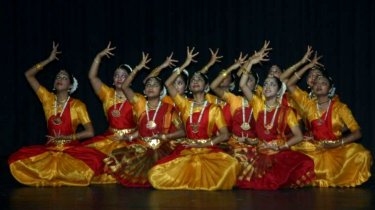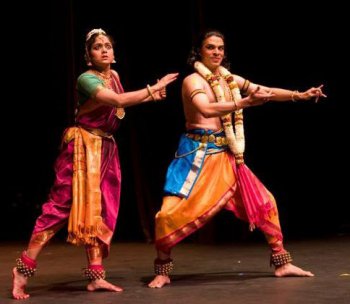
|   |

|   |
Arpan revisited - Arun Madangarli, Atlanta July 15, 2011 Five years after its debut in 2006, Arpan: An Offering, by the Nritya Sankalpa Dance Academy was back again in Atlanta in June 2011. This time the venue was the North Gwinnett High School Theater in Suwanee, and as always, when the curtain rose on the evening of the 25th, the audience realized that they were about to be subjected to an experience crafted with the artistry and sophistication that one has come to expect from Savitha Viswanathan and Nritya Sankalpa. In line with tradition, the program started with the traditional invocatory piece, albeit with a difference; in the place of the customary kouthuvam, the invocation took the form of the Shiva Panchakshara Stotra, said to be authored by the great philosopher Adi Shankara. In this stotra, each of the five syllables that comprise the popular shaiva mantra from the ‘Krishna Yajurveda,’ na-ma-shi-va-ya, is expounded upon to delineate a different attribute of Shiva, the cosmic dancer. Set to music by the late Kadayanallur Venkataraman, this piece was performed with exquisite grace by the senior students of Nritya Sankalpa. The Stotra was followed by Nritta Arpanam, a piece that was pure nritta; an abstract presentation where the rhythms and phrases of the music (composed by Lalgudi Jayaraman for the movie ‘Sringaram’) were translated into beautiful patterns of the body, creating mesmerizing lines in space and time.  Nritya Sankalpa Three pieces followed Nritta Arpanam. The first of these, Unaroo Bharatame, was a semi-classical piece in Malayalam that extolled both the elegant and refined classical arts as well as the vibrant and colorful folk arts of Kerala, within the larger tapestry of the Indian cultural heritage. This was followed by Acham Acham Illai, the legendary song of emancipation from the pen of the great poet-philosopher Subramania Bharati. The younger dancers of Nritya Sankalpa captivated the audience with a lovely adaptation of this enchanting piece, with its music from the soundtrack of the movie ‘Indira.’ The last piece in this segment was a unique interpretation of what constitutes the id – that inaccessible part of our personality which is dominated by instincts and emotions. Titled Vyaktitva, this piece explored the different emotions that make up the human entity, both in isolation and in totality. This piece was noteworthy for another reason; it was conceptualized, choreographed, and performed entirely by the senior students of Nritya Sankalpa.  Sheejith Krishna The second segment was without a doubt the piece-de-resistance of the program. It featured ‘Krishna Bharatam,’ a unique dance drama that evolved from the many-faceted talents of Sheejith Krishna, a dancer par excellence from Kalakshetra. Daring and innovative both in content and in form, Krishna Bharatam explores the complex blend of the divine and mundane, the philosopher and the realist, the reformer and the preserver, and the pacifist and the warrior that is Krishna. In a series of six vignettes that carried the audience through the epic Mahabharata, from the Draupadi swayamvara to the revealing of the Bhagavad Gita, Sheejith presented different faces of Krishna: now a silent witness, now a political agent, anon a saviour of the oppressed, then again, a strategist in war and so on. One of the scenes showing Krishna as an ambassador in the Kaurava court on behalf of the Pandavas was executed entirely in the Kathakali style, even down to the music which consisted of the padams from the Doothu scene of ‘Duryodhanavadham,’ a popular Kathakali play. This bore ample witness to Sheejith’s mastery in integrating different styles of dance and his avant-garde approach towards experimenting with form. Although Krishna Bharatam was originally intended to be a solo performance, it was modified to include two other exemplary dancers; Paulomi Pandit and Anupama Aranaprasad from the Rangashree Dances of India (California) who accompanied Sheejith with impeccable style and grace. The proceeds from this performance under the aegis of the Sankalpa Foundation were to benefit the Children’s Healthcare of Atlanta. The program was an immense success both from an aesthetic point of view as well as a material one and Savitha and the students of Nritya Sankalpa can be proud of providing an evening of enriching aesthetic experience. Arun Madangarli is a control engineer based in Atlanta, Georgia, and interested in all facets of Indian classical arts. |